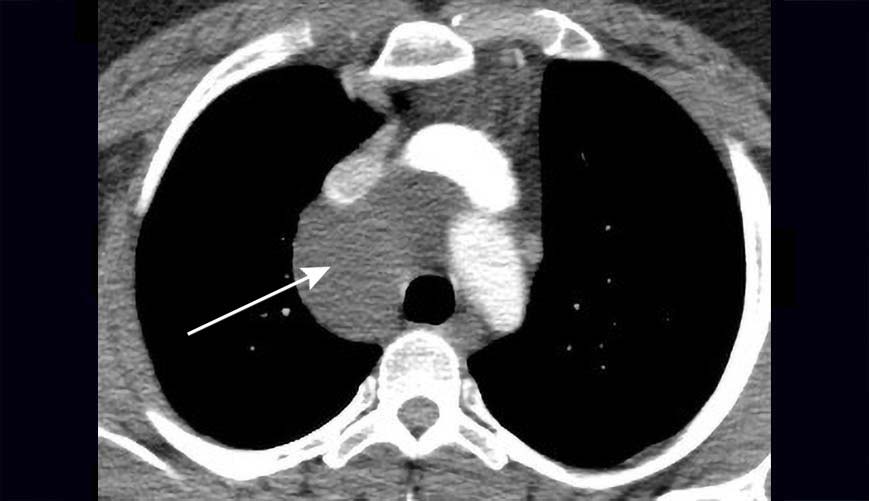Bronchogenic cysts are abnormal growths of tissue that form in the mediastinum — the area of your chest cavity that separates your lungs. Symptoms may include infection, fever and breathing problems. But you can have a cyst and not have symptoms. Healthcare providers may recommend surgery to remove the cysts to avoid complications.
Advertisement
Cleveland Clinic is a non-profit academic medical center. Advertising on our site helps support our mission. We do not endorse non-Cleveland Clinic products or services. Policy

Bronchogenic cysts are a type of mediastinal tumor. They develop in the mediastinum. This is the space within your chest that holds certain blood vessels and organs like your esophagus and trachea. It also separates your lungs. Bronchogenic cysts are congenital, meaning you’re born with them.
Advertisement
Cleveland Clinic is a non-profit academic medical center. Advertising on our site helps support our mission. We do not endorse non-Cleveland Clinic products or services. Policy
You can have a bronchogenic cyst without having symptoms. Healthcare providers may detect a cyst during routine imaging tests. Most people are in their 30s or 40s when a cyst grows large enough to cause symptoms. Learning you’re living with a cyst in your chest may come as an unwelcome surprise. If tests show you or your child has one, your healthcare provider may recommend surgery to remove it.
Bronchogenic cyst symptoms may include:
You can have bronchogenic cyst symptoms at any age. But you may not have symptoms unless the cyst puts pressure on your trachea or esophagus. Bronchogenic cysts may be 2 to 15 centimeters (1 to 5 inches) in diameter. You may also develop symptoms from an infected cyst.
Bronchogenic cysts form during fetal development. Experts don’t know why the cysts form.
Bronchogenic cysts can affect your ability to breathe or swallow and can become infected. But the most serious complication is if a cyst becomes cancerous.
Bronchogenic cysts often show up during routine imaging tests. For example, a prenatal ultrasound may detect a bronchogenic cyst. The cyst may show up if you or your child has chest X-rays as part of a routine examination.
Advertisement
That depends on the situation. For example, a prenatal ultrasound may show the fetus has a bronchogenic cyst. In that case, your obstetrician will monitor the cyst throughout fetal development. If tests show you or your child has cysts, a healthcare provider may order the following tests:
Your healthcare provider may recommend surgery to remove a bronchogenic cyst. Removing the cyst reduces the risk of complications. But their recommendations will be different depending on the situation.
Your obstetrician will monitor the cyst. If it’s very large, they may do a procedure in utero (before birth) to drain fluid from it. Draining fluid can help reduce the risk that the cyst will press on the fetus’ heart.
Sometimes, bronchogenic cysts grow large enough to block a fetus’s airway. This doesn’t happen often. If it does, your obstetrician may recommend you have an EXIT procedure instead of a vaginal delivery or C-section. EXIT stands for ex-utero intrapartum treatment. You receive anesthesia before the surgery.
In this procedure, a surgeon makes a cut in your uterus to lift the fetus’s head, neck and torso through the incision. While the fetus still receives oxygen through your umbilical cord, the surgeon will make an incision (cut) to remove the cyst. After removing the cyst, they’ll cut the umbilical cord, and your obstetrician will deliver your baby through the same cut.
Your newborn baby may not need treatment. Instead, their pediatrician will watch for symptoms that may mean your baby has a bronchogenic cyst. They’ll check on your baby’s overall health during well-baby care visits.
A healthcare provider may recommend surgery like:
Surgery to remove a bronchogenic cyst may cause the following complications:
Advertisement
Complications may be different depending on the type of surgery you have. Your surgeon will discuss potential complications before your surgery.
Your healthcare provider will order periodic imaging tests to check on the cyst. If a cyst grows large enough to affect your or your child’s health, a provider will recommend surgery to remove it.
No, there’s no way to prevent them. Bronchogenic cysts happen during fetal development.
You should contact a healthcare provider if you or your child develops symptoms like:
A provider will order tests to see if a bronchogenic cyst is causing symptoms.
Bronchogenic cysts develop during gestation. In some cases, healthcare providers detect the cysts during routine pregnancy ultrasounds. But you or your child may have a growing bronchogenic cyst for years before the cyst causes symptoms. It can be concerning to learn you or your child has a cyst that can cause complications like respiratory issues or cancer. Your healthcare provider will understand your concerns. You or your child may need surgery to remove the cyst. If that’s the case, your provider will recommend surgery that’s right for you.
Advertisement
As your child grows, you need healthcare providers by your side to guide you through each step. Cleveland Clinic Children’s is there with care you can trust.

Last reviewed on 11/05/2024.
Learn more about the Health Library and our editorial process.